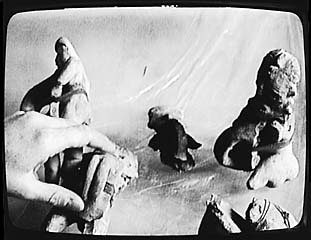|
Beloved Modernity, Who Does Not Forgive
What promised to be the "Age of NAFTA" ended up being the new Burning
Plain.1 During the eighties and nineties, the Mexican government and its
elites invoked, in ever more exalted terms, the idea that Mexico would
finally be integrated into that bleached utopia called "modernity." Despite
the panegyrics, it was a selfish wish. "Modernity" had a clear meaning
in terms of the economic landscape: accelerated privatization, the dismantling
of traditional communal land holdings in the countryside, the internationalization
of capital . . . that orthodoxy that is triumphant capitalism's rights
of conquest.
Hypothetically, becoming "up-to-date" should mean a lifestyle like that
found in the United States and Europe, from the mirage of occidental democracy
to the abundance of McDonald's. But, as is stubbornly demonstrated in
the history of the supposedly "developing" countries, the conduct of "economic
liberalization" cannot be carried out except at the expense of our dreams
of political modernity and with the increasingly perfect distribution
of inequalities. It is not a paradox, but rather a necessary result of
the very violence that "modernization" implies that the Mexican state,
along with its Chinese and Cuban compadres, had to make use of the apparently
unmodern machinery of ideological, military, and political control in
order to impose its restructuring--which modernization could only carry
out under the sign of despotism and repression.
Thus the collapse of 1994&endash;1995: the intensification of conflicts
among religious and economic sectors; the eruption of political violence;
the punctual return of the financial crisis at the end of 1994; the Indian
rebellion in Chiapas and the zeal for drowning it in blood, even at the
cost of consensus. Once more "modernity" showed its true face, appearing
as chaos and social breakdown. How, one must ask, was this chaos expressed
in the field of arts and culture in Mexico? In the likeness and image
of the distorted premise sustaining its government, contemporary culture
in Mexico can be nothing but divided, fluctuating, pallid, and confused.
A grandiloquent mixture of mirages and leaps into the void, swinging between
the resuscitation of Aztec mummies of the government's discourse, the
cosmopolitan dreams of middle-class intellectuals and artists, and the
first stammerings of a possible--but still unrealized--critical culture
that is unable to properly define itself due to the tricks of its enemy,
a criticism that is not articulated because its adversary is cynical and
slippery.
Faced with the impossibility of manufacturing a mythology based on the
holocausts of neoliberalism, the country's political and economic elites
turned their gaze toward that capital, dilapidated now but always available,
which is Mexicanism. The international exhibitions "Mexico: Splendors
of Thirty Centuries" and "Europalia," the Mexican Gallery at the British
Museum, the collaborationism contained in the sterilized enthronement
of the cult of Frida Kahlo, and the transformation of archeological sites
into prospectuses for tropical Disneylands, decorated the ephemeral triumphalism
of the early nineties that needed to reaffirm the national iconographic
apparatus in order to function as a tool of ruthless internationalization.
The old prescription was applied: that of historicist pastoralism. The
government of the world's oldest revolution attempted to alleviate the
absence of an image of the future by trying to reaffirm the thesis of
the continuity of the culture's past without conflicts or divisions, since,
from the perspective of power, Mexico is an entity where massacre and
pillage are hidden behind an image of docility. It is a fruitful association
of the new and the old, in which the modernity of the maquiladoras and
international competition would coincide with the heritage of "Mexico's
greatness," before which any opposition, though it came from the idolatrous
Indians, was simply an avoidable annoyance. It is an image for export
(one that attracts tourism and is sought when Mexico is considered in
the galleries and museums) but an image with a clear sense of itself,
serving as a source of legitimization, interpreting a monopoly of power
in the likeness and image of its monoliths, and defining the terrain wherein
the tasks of intellectuals, writers, and artists--the priests of their
faith--are supposedly located.
In effect, this structure that is Mexico's national culture--which survives
in spite of a domestic television culture inhabited by home-bred Madonnas
who don't mention sex, rap groups without ethnic identity, upper-middle-class
punks--is the desiccated child of the intellectual and artistic battles
of post-revolutionary Mexico. From Vasconcelos to Octavio Paz, from Diego
Rivera to Carlos Fuentes, Mexican intellectuals and artists have constructed
a mythology that is precisely that nation that springs to people's lips
when they speak of "Mexico." A construct which, due to various causes
and political programs, has ended up as an unsalvageable pile of rubble.
And, as Roger Bartra said in La Jaula de la Melancolía (The Cage
of Melancholy), a construct whose main effect is to make it difficult
for contemporary Mexicans to define their political and cultural duties:
. . . the national metadiscourse tends to impede or make more difficult
Mexicans' relationship with their past and with the history of the world:
history is reduced to hieroglyphics, to static symbols destined to glorify
the nation's power and to put good sense to sleep; when one wakes from
this dream it is difficult to recognize one's own past and even the
presence of the world. We have dreamed of a million mythic heroes, but
all that remains of the nation is its ruins.2
Certainly, the cult of nationalism that the Mexican government revived
in recent years had become a moribund religion that nobody but ideologues
and the mass media could take seriously. In 1987, Bartra believed that
the collapse of the idea of a Mexican national culture would cause an
inevitable liberation: the nakedness of "desmodernidad":3
Mexicans have been expelled from their national culture: this is why
Mexicans pay less and less homage to a metamorphosis thwarted by melancholy,
to a progress castrated by backwardness. Mexicans see themselves less
and less as that axolote4 which the mirror of national culture offers
them as a paradigm of unifying nationalist stoicism. They are not enthusiastic
about efficient modernity, nor do they want to revive the promise of
a proletarian industrial future. Neither do they believe in a return
to the Golden Age, to incipient primitivism. Cast out of their native
paradise, they have also been expelled from the future. They have lost
their identity, but they don't mourn it: their new world is an apple
of discord and contradictions. Without having been modern, they are
now unmodern; they are no longer like the batrachian, they are other,
they are different.5
Still, theory is one thing and ideology is another. In spite of its sterility,
Mexican identity, like that of the PRI (Mexico's rul- ing Institutional
Revolutionary Party), is a corpse in good health. In spite of its increasingly
frequent appearance in sensationalist political headlines around the world,
Mexico continues to cash in on its aroma of cultural peculiarity to the
degree that, as a metropolis, it often supplants the image of Latin America.
It is a mask that conceals, since each idealization of lo mexicano must
be countered with its sociological nemesis: racism with the Museum of
Anthropology, Catholic moralizing with the improbable eroticism of Like
Water for Chocolate, the PRI dictatorship with the country of surrealism.
The culture of Mexico is the vision projected in the eyes of Mexican
presidents when they decide to "disappear" their opponents, or assassinate
them.6 It is that entity that gives credence to the paranoia of domestic
and foreign threats, that validates the authoritarian acts with which
our government periodically oils the machinery of those businesses that
are its sole true interest.
One could, like many others, act as if artistic and literary work had
nothing to do with such constructs of history, and create a "metropolitan"
culture in spite of the curse of nationalism and the atrocities committed
in the sacrosanct name of Mexico. But acting as if a situation does not
exist just tends to perpetuate it; the task of dynamiting the Mexicanist
culture of power has barely begun. The reformulation of Mexican culture
that would turn it into a living and liberating entity is still a dream.
If the national culture that poisons us is a religion of empty tyrannical
images, a subversion is called for that would also be iconographic. At
times this would seem to be irony disguised as candidness, at others a
revelation of facts contradicting dogma, at still others an amusing sacrilege:
as false idolatry, as syncretic dislocation, or as an eschatological profanity.

Javier de la Garza, Aparición de la Papaya, 1989; courtesy of
Galería OMR, Mexico City
The Aztec Ghosts
For nine years Javier de la Garza has been painting narratives about
the impossibility of Mexico, stories in which the poetry and themes of
nationalist mythology are fleshed out as a demonstration of their improbability.
These are epiphanies of idolatrous falsehood.
I think nobody could fail to notice that de la Garza's strategies are
directly related to those that prevailed in western painting during the
eighties: roughly paraphrasing the appropriation of the styles and icons
of the first vanguards or stages in the "history of art"; the utilization
of ideograms and boxed texts as if to call upon the viewer's skepticism
at the ability of painting to transmit its own discourse; the tendency
to present more or less central and dominant figures standing out against
a background that is not a setting but rather a decorative montage of
saturated surfaces, before which the figures clash with their apparent
immobility and volume. But, above all, de la Garza's paintings reveal
his affiliation with paintings of the eighties in the way in which they
are offered as a kind of personal mythology where the paintings seem marked
with an excess of oratory accompanied by the impossibility of reading
it; this happens either because the painting produces in the viewer an
assumption that the artist is keeping some meaning to himself that is
displayed as much as it is occluded, or because it combines the stridency
of its "messages" with a lack of articulation of its parts.
De la Garza's paintings echo the "postmodern" concern that an opulence
of information is a guarantee and expression of the absence of meaning.
Thus his work tends to take refuge between mysticism and irony, between
the symbolic image and informational indigestion. In this sense, his paintings
have meaning only when one considers them in the context that they criticize
by reinventing it, the context of the iconography of Mexicanness that
Mexican painters and filmmakers developed from the twenties to the fifties,
especially those of the sentimental and kitsch branch of melancholy nationality:
the films of El Indio Fernández photographed by Gabriel Figueroa,
the calendars of Jesús Helguera, María Izquierdo's "metaphysical"
paintings and the untouched martyrdom of Frida Kahlo, the cult of the
Virgin of Guadalupe and Aztec sculpture.
In fact, Mexican art criticism classified de la Garza as part of a movement,
which was called "neo-Mexicanism"--a designation that tends to disguise
it as mere revival, so that nostalgia also served to nourish official
iconography. This was a current which, as art historian and critic Olivier
Debroise observed, began in the eighties as an alternative to the internationalization
predominant in Mexican art of previous decades, but that became a kind
of mainstream for Mexican painting by mid-decade, with all the risks and
contradictions that that involved. Paradoxically, what began as irony
became a commercial success, partly because it reinforced an image of
Mexican painting recovering its national character, but also because it
coincided with North American art's new interest in cultural identity.7
Evidently, de la Garza was not trying to pose the reinvigoration of the
national myths in his painting, but he cannot deny having participated
in this to some degree. Meanwhile, the fact that a taste for his work
developed is proof that fossilized Mexican rhetoric is more than capable
of assimilating even its heresies. De la Garza has experienced the ambiguities
relevant to his points of reference, particularly the difficulty of adequately
distinguishing between criticism and homage. His works incorporate that
ambiguity, and play on the possibility that the viewer will take them
as authentic expressions of the neo-Mexican, while his real intention
is to emphasize a paradoxical distance from nationalist myths.
The Border: A Place, Everyplace
One of the paradoxes of Mexicanist culture is the fact of having built
its dreams in praise of the mestizo while continually feeling threatened
by the possibility of new cultural mixtures. Specifically, it always experiences
the threat of meltdown when faced with an image of the American way of
life. The other side of the illusion of cosmopolitan Mexican culture is
the image of its declining folk culture: as long as the Mexican upper
classes define themselves mimetically, they reinforce their dream of the
lower classes being identical to their original models, as if cultural
assimilation were part of their monopoly on privilege.
Even before going to Los Angeles to study at the California Institute
of the Arts, Rubén Ortiz Tórres had shown a special interest
in the way in which Mexican and Catholic cultural icons have been affected
by the emergence of commercial mass culture in Mexico. However, in recent
years his closeness to the border lifestyles that have developed among
Chicanos and residents of northern Mexico suggested the need to use these
images as a field for the study of cultural misunderstanding.

Rubén Ortiz Tórres, Graceland Apparition / El Vez, 1991;
courtesy of Jan Kesner Gallery, Los Angeles
Rubén Ortiz bases his work on the idea that all cultural identity
is a hard-won construct of abstraction: the cleanness of disturbing aesthetic
elements and the freezing of certain features that are raised to the status
of cultural principles, such as the images of Mexico as a rural reservoir
of popular Catholicism, and of the United States as a theme park of industrial
progress. All identity--and the representation of lo mexicano is an exemplary
case--is a political construction. But what is significant in this construction
of identity is that despite its artificiality, it ends up being assimilated
and applied in daily life, creating a constant instability and an abundance
of paradoxes. As Ortiz demonstrates in his video Como leer al Macho Mouse
(How to Read Macho Mouse), Emiliano Zapata is caricatured as Speedy González;
similarly, Mexican artisans make clay sculptures, in the most traditional
style, portraying Donald Duck. Ortiz is particularly interested in those
cases that break with cultural taxonomies and generate unexpected dialogues:
for example, the way in which the U.S. obsession with the danger of invasions
from outer space, provoked in part by immigration, is reflected in Tijuanan
paintings on velvet of E.T.
According to Ortiz, the artist's task is not to represent this chaos
and put it in order, but to confront the public with the representations
that have been made of it, and perhaps to provoke with the disinterested
black humor of his own reflections. Thus, Ortiz documents and selects
the way in which living culture is practiced in terms of its symbolic
abstractions, partly because he is fascinated by that vitality (for example,
the opulence of Chicano Low Rider cars) and partly because living culture
can only be simultaneously tragic and comic.
His work is a challenge both to the idea (often dreamed of by Mexican
artists) of a pure "international" artistic language, and to the utopian
notion of representing the identity of a culture through art. In this
sense, his work is distinct from Chicano art, which often aspires deliberately
to being a symbolic representation of the state of border culture. In
contrast, especially in his color photographs, Rubén Ortiz has
concentrated on showing that the same evanescence exists in the concept
of the Mexico-United States border, whether the moment of the impossibility
of recognizing the identifying features of a place is being documented
and dramatized in Los Angeles or Mexico City (or many other places). He
is interested in those moments when the border is no longer just the Rio
Grande dividing line, but becomes a possibility that is latent in any
place in North America. Such scenes show the border to be not a place
but an aesthetic disturbance.

Ejército Mexicano, Rubén Ortíz Torres. 1992
Recently, Rubén Ortiz has tried to go from the observation of
this dislocation to direct intervention. His baseball caps are more than
an ironic commentary on the way the emblems of sports teams appropriate
cultural stereotypes; they also construct the possibility of a future
Mexican-North American identity--one of the conquest and politicization
of mass culture. If these caps were actually fashionable, the cultural
industries would circulate not just the stereotypes but the paradoxical
and self-critical images of the discourse about identity. Basically, Ortiz
tests the possibility of surpassing the reservoir of art. His work looks
toward a different audience, one for which representations are more than
just something to be enjoyed, an audience for which representations may
become political weapons: a purely hypothetical audience, probably improbable,
but many times implicit in the multiculturalist standpoints. The baseball
caps presented as utopian projects, caged in their vitrines, make even
more evident the inconvertible distance between artistic practice and
mass culture.
Incest
Let's explore the premise that ideologies are secular religions, that
they turn history into a sacred, fossilized, inaccessible narrative, a
written theogony. Museums, with their objects displayed out of reach,
devoid of all context or contact, manifest that narrow vision of the past
and of tradition, consecrating the idea that only that which is no longer
available is culture. It is not just that governments rewrite history
to justify their political power, but that once they do this they wall
history up so it will not propitiate subversive ideas. The education that
inoculates us with one version of history tends to present that version
as irrevocable fact, in spite of the fact that academic research on the
past is constantly being rewritten, and in spite of the fact that popular
historical narratives (such as myths) are constantly erased and reconstructed
in the plasticity of memory and the spoken word. One of the keys to hegemony
is to keep identity and history always present, while maintaining statism
at a distance. In this sense, contact with the past takes place under
strict control--paternal control.
In her installations, action videos, and objects, Silvia Gruner has been
trying to give form to a concern that we might call sacrilege: approaching
memory through corporal contact, dislocating the untouched appearance
of history and tradition by means of eschatological eroticization. In
a way analogous to how Catholic mystical theology periodically disturbs
the structure of official Catholicism, Gruner invites the viewer to have
unmediated access to the signs of her culture. Thus, her works frequently
emphasize a kind of aura contained in objects: the soul residing in horses
or in a bed, the historical presence that phantasmatically inhabits convents
and houses, or the iconography of holiness incorporated in a suit. And
thus her images, such as the fragrance and color of the soap in one of
her installations, are physical emanations and not just visual objects.
Of course, this sacred contact with culture cannot take place without
a trace of irony. Silvia Gruner's ceremonies arrive at a certain moment
when they bite their tails and metamorphose into jokes and games. Perhaps
in this way Silvia tries to ward off the dangers to which a feminist perspective
is exposed when it deals with tradition: that is, the temptation to personify
it. It is not surprising in the case of Mexico that women such as Frida
Kahlo, María Izquierdo, and Tina Modotti are mythicized just when
the model of national cultural identity is in crisis; since women tend
to be conceptualized with the untouched and irrational essence of nature
and culture, for this reason they are summoned when traditional certainties
are shaken.
In Don't Fuck With The Past, You Might Get Pregnant (1994), Gruner has
perfectly joined this theme of the past taken by force with the need to
oppose the myth of femininity as the paradise of identity. The video and
stills are presented ambiguously as private ceremony or pornographic archeology.
A series of tepalcates, broken clay figures from pre-Columbian agrarian
religions that are still frequently turned up in tilled fields, are newly
fertilized by the artist's hand. That hand draws the idols to a contact
denied by historical narrative, while at the same time representing the
past as fornicatable material, as the object of violence. The idol is
screwed; the woman's hand paradoxically becomes a phallus. (It is not
in vain that patria --Spanish for country, root of "patriotic"--is a feminine
derivative of pater.) But as the title of the piece suggests, the escapade
is self-rape; it is the artist, and not the past, who might be impregnated
by the contact. One would like to see in this "ravishing of the coatlicues"
the possibility of freeing the past from its dogmas in order to re-link
it with new tasks and a new present.

Silvia Gruner, Don't Fuck With The Past, You Might Get Pregnant (detail),
1994
The isolated, anxious gestures of these images are a metaphor for the
tentative pursuit one would like to make of identity and history once
the official narrative has expired. It is not in vain; the ancient mythologies
tear at us subversively as incest.
The United Nations of Art
International exhibitions come and go; they are the thermometer of the
nascent culture of the end of the century. It is no coincidence that they
take place. While markets are inundated, in an increasingly irreconcilable
and expatriate mass of products, with jeans made in Thailand, Japanese
tequila, South African wine, and Brazilian PCs, the arts aspire to the
formulation of a clarified, self-aware exchange of provenances.
Certainly this cultural representation is problematic. On the one hand,
the multiculturalism that apparently dominates the world art scene tries
to be the antidote to that inferno of galactic uniformity that was imagined
in the metropolis to be the result of international modernism. But, on
the other hand, multiculturalism also presents us with the concept of
"national cultures" that romanticism formulated for modern states.
Nevertheless, the international exhibitions that we present and observe,
contain, like a sin by definition, the assumption that the artists and
the works of art represent their countries; the audiences that attend
them continue to expect these exhibitions to reveal some truth about,
say, for example, "Mexico and Ireland." This is an illusion; the experience
of a society cannot be summarized in an object or image. Yes, a work of
art can be involved in the task of giving momentary meaning to a contradictory
mass of stimuli--it can, perhaps, aspire to becoming a point of reference
or a talisman to help us get through a volatile context--before it falls
into the bin of frozen definitions of "cultural patrimony."
But even so, there is a trap, and the trap is set. The fine arts live
by the fraud of their transparency. The public walks through the halls
of galleries and museums and consumes, instamatically, an image that is
practically by definition an immediate unit of meaning, which, in spite
of being contradictory and bloody, can be viewed in a second and assimilated
like a slogan. We visit Babel as tourists and come back with a snapshot.
The Snapshot
No image can be more eloquent than the snapshot, precisely because it
is so anti-glamorous. Nothing in it refers to the aesthetics of war, with
its close-ups of resplendent activity and its shameless pursuit of suffering
with a human face or glory that has not yet been exterminated--all those
signs that are precisely what make an image seem documentary, shouting
at us about how important it is. Just the opposite: the decomposition
of the scene contains much of the simplemindedness of those shots that
stuff family albums in the age of the Instamatic. The actors do not play
at rhetoric with their gestures, and nothing in their modesty would seem
to give away the act they are committing. There is nothing in them of
the savage macho mixture of bandido and hero that feeds the fears of those
who predict the awakening of the so-called "Bronco Mexico." They are nothing
like the Ché Guevarian guerrilla fighters of student dreams or
middle-class nightmares. Something in them makes myths leap out, as well
as demons.

Finca Liquidambar, Angel Albino Corzo, 1994. Photo by Omar Meneses /
La Jornada
The workers on the Liquidambar ranch in Angel Albino Corzo, in the Mexican
state of Chiapas, have taken over the house of the hacienda's owner. It
is September, 1994; the photo was taken by Omar Meneses for the newspaper
La Jornada. On the walls above the lintel hang four silk-screened prints
by Andy Warhol.
One of them, the one on the left, hangs crookedly--as crookedly as the
portraits of Benito Juárez or the president tend to hang in Mexican
public schools. Marilyn, eternally murdered in her smile, looks dispossessed
and bored in her glass prison--so far from the spotlights of Hollywood,
as far as the peasants are from Diego Rivera's murals. The photo--which
I suppose would be envied by Louise Lawler--shows not only the domestication
of art in this setting of neocolonial furniture and lamps of doubtfully
aristocratic European parentage, it also makes visible the nature of a
contradiction experienced as regularly as our daily bread. No, as romantically
and demagogically as we might wish, it is the contradiction of the inability
to decide between the past and the future, between poverty and development.
Not the halting steps of a transition, but a wound in the social imagery
that opens more and more because the government discourse is trying to
close it.
Here are the revolutionary Indians, in whose name the Mexican government
still governs, and who are the government's worst nightmare. This is the
Mexico that the sanitized, drugged image of our national culture does
not begin to comprehend, and thus eliminates. The Mexico of growing incomprehension
and uncontrollable discontent. What happened to our surrealist country?
What happened to magical realism?
In all this, there is only one real shame. The Mexican culture must be
true to its anger, or it deserves to be no more.
Translated from Spanish by Ellen Calmus
Notes:
1 A reference to Juan Rulfo's novel Llanoen llamas.
2 Roger Bartra, La Jaula de la Melancolía: Identidad y Metamorfosos
del Mexicano (The Cage of Melancholy: Identity and Metamorphosis of the
Mexican) (México: Editorial Grijalbo, 1987), p. 241.
3 Bartra's term alludes both to the literal sense of "un-modernity" and
the Mexican slang concept of "desmadre" ("without mother"), which means
both chaos and uncontrolled feast, depending on the usage, while implicitly
referring to "illegitimacy."
4 Axolote is a peculiar batrachian of the salamander family that lives
in the lakes of Mexico; it is well-known because it reproduces itself
in a larval state, and can stay in that condition until the end of its
life without metamorphosis.
5 Bartra, La Jaula de la Melancolía, p. 242.
6 The link between a homogeneous definition of Mexicanist identity and
the authoritarian behavior is well proved by the central argument Mexican
president Ernesto Zedillo used when he launched the failed military offensive
against the Zapatista army on the 9th of February, 1995: ". . . the origin,
composition of the leadership, and the goals of the group [of the Zapatista
Army] were neither popular, nor indigenous, nor from Chiapas. . . . [and]
. . . clearly represent a threat against the Mexican people and public
order." (México: Presidencia de la República. Dirección
General de Comunicación Social, Press Statement no. 150, February
9, 1995, pp. 3-4). Independently of the question concerning the legitimacy
of the government actions, what distinguishes them is the idea of excluding
and criminalizing all actions that do not
correspond with the public image of the identity of the population. This
implicit charge of "anti-Mexican activities" explains a great deal about
the vital importance of the cultural narrative for the Mexican regime.
7 Olivier Debroise, "Javier de la Garza: fusiones," introduction to the
exhibition catalogue Javier de la Garza (Mexico City: Galería OMR,
1993), p. 14.
|